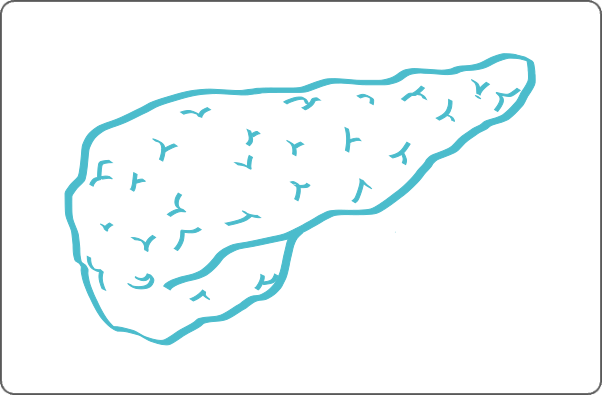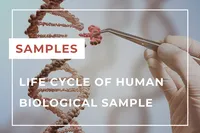Home › Biological sample › Cancer › Pancreas
Pancreatic cancer biological samples:
Research application and procurement
The development of drugs and diagnostic tests for the treatment and detection of pancreatic cancer requires conducting studies on biological samples obtained from patients with pancreatic cancer.
A brief overview of the various types of pancreatic cancer and how the services offered by Labtoo contribute to accelerating research and development projects in the pharmaceutical industry.


Are you looking for biological samples from pancreatic cancer patients?
What are pancreatic tumors?
The pancreas, a retroperitoneal organ located behind the stomach, plays a central role in metabolic homeostasis as a multifunctional actor within the organism. Comprising two main regions, the exocrine and endocrine, the pancreas orchestrates functions related to blood glucose regulation and nutrient digestion. Its exocrine activity is manifested by the production of digestive enzymes, transported to the duodenum, while its endocrine role is characterized by the secretion of insulin and glucagon, vital hormones for precise control of carbohydrate metabolism.
Nearly all pancreatic cancers arise from pancreatic exocrine cells, normally responsible for the synthesis and release of digestive juices. These tumors, primarily ductal adenocarcinomas or PDAC, account for approximately 95% of pancreatic cancers. They typically originate in the pancreatic ducts but can also develop in the head, body, or tail of the organ.
The remaining cancers, although much rarer, originate from other types of pancreatic cells. Some of these cancers arise from pancreatic endocrine cells, which produce hormones. For example, insulinomas form from cells producing insulin, while glucagonomas originate from cells producing glucagon.
Due to the often asymptomatic nature of pancreatic cancer in its early stages, it is frequently diagnosed late, contributing to its metastatic tendency. Common metastatic sites for pancreatic cancer typically include the liver, lymph nodes, lungs, bones, and the peritoneal membrane.

| Type of Pancreatic Cancer | Cell of Origin | Frequency |
|---|---|---|
| Ductal Adenocarcinoma (PDAC) | Exocrine cells of ducts | ≈ 95% |
| Insulinoma | Islet Cells (Endocrine) | > 1% |
| Glucagonoma | Islet Cells (Endocrine) | > 1% |
| Acinar Cell Cancer | Acinar Cells (Exocrine) | Rare |
| Pancreatic Neuroendocrine Tumor (PNET) | Neuroendocrine Cells | Rare |
Explore Labtoo's Service for Your Biological Sample Research
Labtoo assists you in sourcing biological samples from pancreatic cancer patients. Our team manages the entire project of transferring biological materials from inception to sample delivery.
- Feasibility assessment of sample availability or clinical collection from referenced clinical centers
- Validation of regulatory aspects
- Establishment of a contractual framework
- Dispatch of desired samples under appropriate conditions
- Transfer of associated clinical data
- Additional analytical and experimental services
Types of available samples
Fresh tissues
After a tumor resection or a biopsy, a pathologist can decide whether the tissue sample can be used for research. Labtoo can organize the conditioning and shipment of fresh pancreatic cancer tissue in 24-48 hours after surgery.
Frozen tissues (OCT and FF)
Similarly to fresh tissue, once the tissues are cleared for research, the clinical site can freeze and keep the frozen pancreatic cancer tissue samples at -80°C or in liquid nitrogen for ulterior use.
FFPE Tissues
Pathologists typically embed the biopsies and resections in paraffin. FFPE blocks of pancreatic cancer tissues can be used later for research.
Adjacent Healthy Tissues
Tumor resections typically include healthy adjacent pancreas tissue during the process. This tissue can later be used for research and act as controls for diseased tissues.
- Plasma or Serum from pancreatic cancer patients
- PBMC (Peripheral Blood Mononuclear Cells)
- Whole Blood
- Leukapheresis
- Urine
- Feces
- Other
Typical associated clinical data
-
- Age
- Gender
- Ethnicity
- TNM Classification
- Undergone Treatment
- Medical Imaging
- HIV/HBV/HCV status
- Mutations
- Other Data (upon request)

Labtoo identifies clinical sites that can prepare and transfer sample collections tailored to your specific project needs.
Contact our team to discuss your project.
Send your request to our team:
The stages and grades of pancreatic cancer
The stage and grade of cancer are commonly used together to provide a comprehensive assessment of the disease and guide optimal treatment.
The determination of the stage of cancer is primarily based on the TNM classification, which evaluates the size of the tumor (T), the involvement of lymph nodes by cancer cells (N), and the presence of metastases in other parts of the body (M). In parallel, the grade provides an indication of the degree of differentiation of cancer cells.
Regarding the grades, noted from 1 to 3, grade G1 indicates well-differentiated cells resembling normal cells, grade G2 represents moderately differentiated cells, and grade G3 indicates poorly differentiated cells, suggesting faster and potentially more aggressive growth.
As for the stages of pancreatic cancer, they are represented as follows:
Stage I
The tumor remains at the level of the pancreas, with no involvement of lymph nodes.
Stage II
The tumor measures more than 4cm or has invaded a maximum of 3 lymph nodes.
Stage III
The tumor has spread to blood vessels or involves more than 4 lymph nodes.
Stage IV
Cancer has spread to distant organs (metastases), such as the liver, lungs, or other parts of the body.

Rare forms of pancreatic cancer
It happens that rarer forms of pancreatic cancer develop, among them:
-
Islet Cell Tumors
These tumors originate from the pancreatic islets of Langerhans. Various types are distinguished, such as insulinomas, which cause overproduction of insulin, glucagonomas (excessive production of glucagon), gastrinomas (excessive production of gastrin), and others.
-
Acinar Cell Cancers
These cancers arise from pancreatic acinar cells, responsible for the production of digestive enzymes.
-
Adenosquamous Carcinoma
This is a cancer characterized by the coexistence of glandular and squamous cells. This type is exceptionally rare and exhibits particular aggressiveness.
-
Fusiform Cell Tumors
These tumors, also rare, can develop from various pancreatic cells.
Pancreatic cancer treatments and advances
The treatment of pancreatic cancer depends on the type of cancer, its stage, and the patient's physical condition. The main therapeutic modalities planned to treat this type of pathology are:
-
Surgery: It is often the preferred treatment when the tumor is localized and can be completely removed. A pancreatectomy (removal of part or all of the pancreas) may be performed. However, most pancreatic cancers are diagnosed at an advanced stage where surgery is not always possible.
-
Radiotherapy: Radiotherapy uses radiation to destroy cancer cells or prevent their growth. For pancreatic cancer, it is often used in conjunction with chemotherapy.
-
Chemotherapy: Chemotherapy uses cytotoxic drugs to target and kill cancer cells. It can be administered to reduce the size of the tumor, treat remaining cancer cells, and prevent recurrence.
Currently, immunotherapy and targeted therapy methods are not used in the treatment of pancreatic cancer. Nevertheless, several clinical studies are ongoing.




